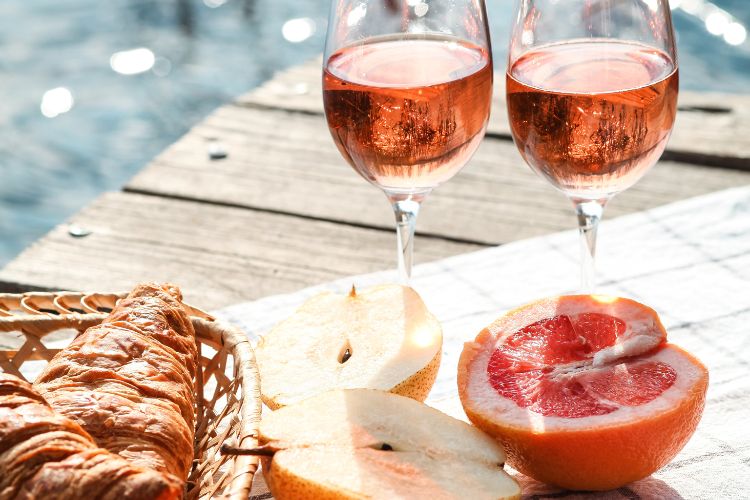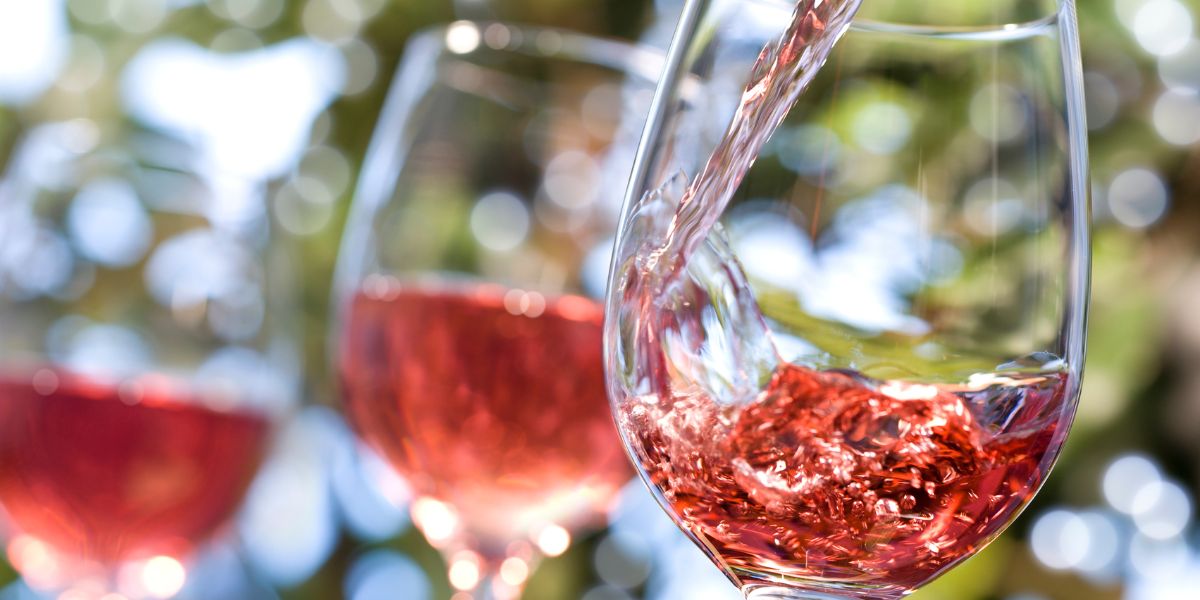How to Pair Food with Dry Rosé Wine
What isn’t a great pairing with Dry Rosé?! Rosé is such a broad category of wine with light, subtle options from southern France, Italy, and Spain to bolder options like those from California, Central France, or South America (and so many in between from virtually every wine producing region on the globe).
Pairings really depend on which grape(s) the rosé is comprised of. In general, rosé can be thought of as an “in between” option, as it is “in between” a red and a white wine in style. It often has the red fruit aromas of a red wine, with the lighter body and crisp acidity of a white wine.
Best Food Pairings for Dry Rosé Wine
Rosé, in its delightful array of styles, is indeed a versatile wine that can complement a vast spectrum of foods. With a perfect equilibrium between the fruity depth of reds and the refreshing crispness of whites, dry rosé can enhance any meal, provided you choose the right pairing. Let’s delve into some of the best food pairings for dry rosé wine.
RELATED: The Ultimate Guide to Food and Wine Pairing

Seafood Dishes to Pair with Dry Rosé Wine
The light, often mineral-driven nuances of dry rosé wines, especially those from Southern France or Italy, harmonize beautifully with the delicacy of seafood. Be it a buttery lobster, grilled shrimp, or a light fish dish like cod or sole, the crisp acidity of dry rosé complements the sea’s salty sweetness without overshadowing its flavor.
Poultry and Meat Dishes to Pair with Dry Rosé Wine
On the other side of the spectrum, the fruity undertones of rosés from regions like California or Central France make them an excellent match for poultry and lighter meat dishes. A roasted chicken or turkey, grilled pork chops, or even a medium-rare steak can benefit from the medium-bodied, berry-infused charm of a robust dry rosé.
Vegetarian Dishes to Pair with Dry Rosé Wine
Vegetarian cuisine finds a delightful partner in dry rosé. The light body and dynamic flavor profile of dry rosé balance the natural flavors of vegetables, grains, and legumes. A Mediterranean-style salad, a hearty quinoa bowl, or a vegetable stir-fry would pair splendidly with a glass of refreshing dry rosé.
Cheese and Charcuterie to Pair with Dry Rosé Wine
The spectrum of dry rosé wine can handle a broad array of cheeses and charcuterie. From creamy brie and tangy goat cheese to salty prosciutto and spicy sausages, dry rosé provides a counterpoint that enhances these bold flavors, making it an ideal choice for a charcuterie board.
Desserts and Sweets to Pair with Dry Rosé Wine
Dessert pairings depend largely on the rosé’s residual sweetness. A drier rosé could pair nicely with a light lemon tart or a bowl of fresh berries, enhancing the dessert’s fruity notes without overwhelming its sweetness. Remember, the art of food and wine pairing lies in balance, and dry rosé is a versatile artist that can harmonize with a broad palette of flavors.
RELATED: Buy Jaclyn’s Complete Guide to Wine and Food Pairing on Amazon
Tips for Pairing Dry Rosé Wine
Dry rosé, with its extraordinary breadth of flavors and characteristics, offers endless possibilities for culinary pairings. Yet, it’s important to keep a few key principles in mind to truly elevate your dining experience. Below are some useful tips for pairing dry rosé wine with your meals.
Understanding the Balance of Flavors
One of the first steps in successful wine pairing is understanding the balance of flavors. Both the dish and the wine should complement each other, allowing each element’s unique characteristics to shine without overpowering the other. For instance, a subtly flavored dish could be overwhelmed by a robust rosé, and a wine with delicate notes might be overshadowed by a heavily spiced meal. Striking the right balance ensures that both the food and the wine enhance each other’s best qualities.
How to Match the Weight of the Wine with the Dish
The concept of ‘weight’ or ‘body’ – light, medium, or full – is crucial in food and wine pairing. A light-bodied dry rosé, like those from Southern France, pairs well with light, delicate dishes such as grilled fish or salads. On the other hand, fuller-bodied rosés from regions like California can stand up to more substantial fare like grilled meats or hearty stews. Matching the weight of the wine to the dish can help to ensure a harmonious pairing.
Pairing Rosé with Spicy Food
Dry rosé wines, particularly those with a hint of sweetness and good acidity, can be a great match for spicy foods. They can help balance the heat and bring out the different flavors in the dish. Think Asian or Indian cuisine, where the complexity of spices can be complemented by a refreshing, fruit-forward rosé.
Seasonal Pairing Tips for Dry Rosé Wine
While rosé is often associated with summer, its versatility makes it a wine for all seasons. Light, crisp rosés are perfect for warm weather – think picnics or poolside barbecues. As the weather cools, turn to fuller-bodied rosés, which can pair well with autumnal roasts and winter stews. Remember, the beauty of wine pairing lies in experimentation and personal preference, so don’t be afraid to break the rules and find the combinations that you enjoy the most.
Regional Rosé Wine Pairings
If you look to specific rosé regions for pairings, you also won’t be disappointed. Serrano ham and manchego cheese with a Spanish Garnacha rosé/rosado is a divine pairing.
Provence rosé is remarkable with a classic Salad Niçoise and heartier Tavel rosés are great with smoked chicken or pâté.
Look beyond classic pairings and you will discover just how endless rosés pairing possibilities are. Mexican, Szechuan, Thai, Hawaiian… all regional cuisines without traditional wine pairings, but fantastic with rosé!
Understanding Rosé Wine
Dry rosé wine, celebrated for its versatility and refreshing character, has been gaining quite the momentum among wine enthusiasts worldwide. But what makes it unique? How does it differ from its rosé counterparts? Let’s delve into the world of dry rosé wine to understand its production process, distinctive qualities, and flavor profiles.
The Production Process of Dry Rosé Wine
Dry rosé wine is usually crafted through one of two methods: the ‘skin contact’ method or the ‘saignée’ (bleeding) method. In the skin contact method, red grapes are crushed, and the skins are allowed to macerate with the juice for a brief period, imparting the wine with its characteristic pink hue. The saignée method, on the other hand, involves “bleeding off” some juice from a vat of red wine early in the fermentation process, then fermenting this juice separately to produce rosé.
What determines the “dry” nature of rosé is the fermentation process. The yeasts consume all the sugar in the grape juice, resulting in a wine with minimal residual sugar, thus creating a ‘dry’ wine.
Differentiating Dry Rosé from Other Types of Rosé

While all rosé wines share a common pinkish hue, the level of sweetness is what differentiates dry rosé from other types of rosé. As mentioned, dry rosé wines have little to no residual sugar, rendering them less sweet than their counterparts. Conversely, sweet or semi-sweet rosés have a higher level of residual sugar, which lends them a perceptible sweetness.
Key Characteristics and Flavor Profile of Dry Rosé Wine
Dry rosé wines are admired for their bright acidity, varied fruit flavors, and, as their name suggests, a lack of sugary sweetness. They tend to feature notes of red fruits like strawberry, cherry, and raspberry, often accompanied by hints of citrus, melon, or peach. Floral, herbaceous, and mineral notes can also be present, depending on the grape variety and wine-making techniques. The body of dry rosé can range from light to medium, making it a highly food-friendly wine with a wide array of pairing possibilities. Remember, while these are typical characteristics, the actual profile can vary significantly based on numerous factors, including the region, grape variety, and winemaker’s style.
The Basics of Food and Wine Pairing
Food and wine pairing is an art form that brings together the distinct flavors of cuisine and wine to create an elevated dining experience. This intricate dance of aroma, texture, and taste, when done right, can turn any meal into an exquisite feast. And dry rosé wine, with its diverse characteristics, holds a special place in this realm. Let’s explore the basic principles of food and wine pairing and delve into why dry rosé wine shines in this domain.
The Concept and Principles of Food and Wine Pairing
Food and wine pairing revolves around the idea of synergy and balance. The goal is to bring together food and wine that complement and enhance each other’s qualities without overpowering one another. Basic principles such as matching the wine and food’s weight or body, considering the dish’s primary flavors, and balancing the wine’s acidity or sweetness with the food’s components are crucial. Yet, it’s also about personal preferences and exploration, which makes the whole process more exciting and personal.
Why Dry Rosé Wine is Versatile for Pairing
Dry rosé wine, with its broad spectrum of flavors and structures, is arguably one of the most versatile wines for food pairing. Its high acidity and diverse fruit profile allow it to complement a wide range of foods, from delicate seafood dishes and hearty meat preparations to complex spicy cuisines. Furthermore, its balance between the depth of red wine and the crispness of white wine makes it an all-around player, capable of bridging the gap between food and wine in a harmonious and delightful way. Therefore, whether you’re planning a casual brunch, a formal dinner, or a spicy feast, dry rosé wine can be your go-to choice for a versatile and enjoyable pairing.
Frequently Asked Questions about Rosé Food and Wine Pairing
You are reading “Rosé Food and Wine Pairing Guide”: Back To Top
food pairing rose, what pairs well with rose wine, rose wine pairing: educational wine articles
If you enjoyed this guide, consider joining the Facebook Group to interact with other Winetravelers and for wine travel inspiration around the world. Be sure to follow us on both Twitter and Instagram to stay up to date with our trending content.
